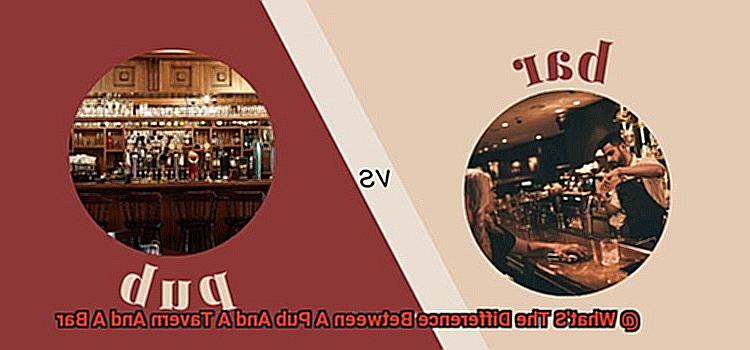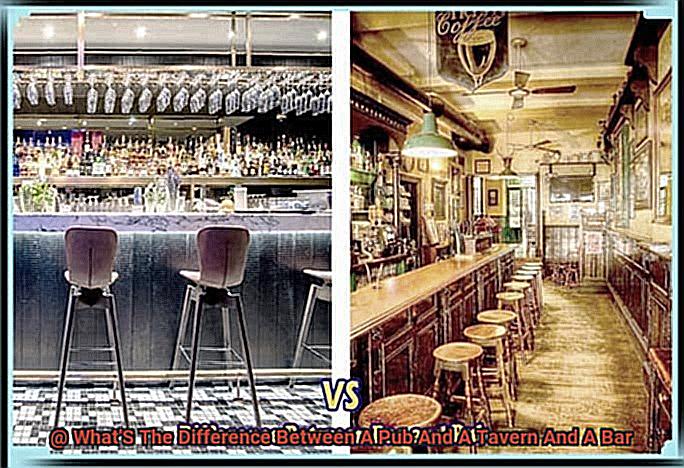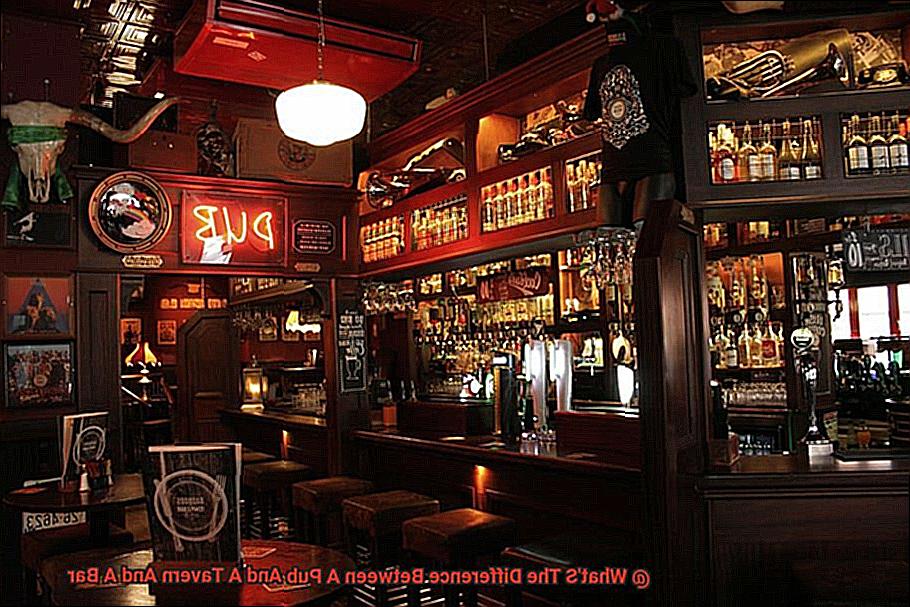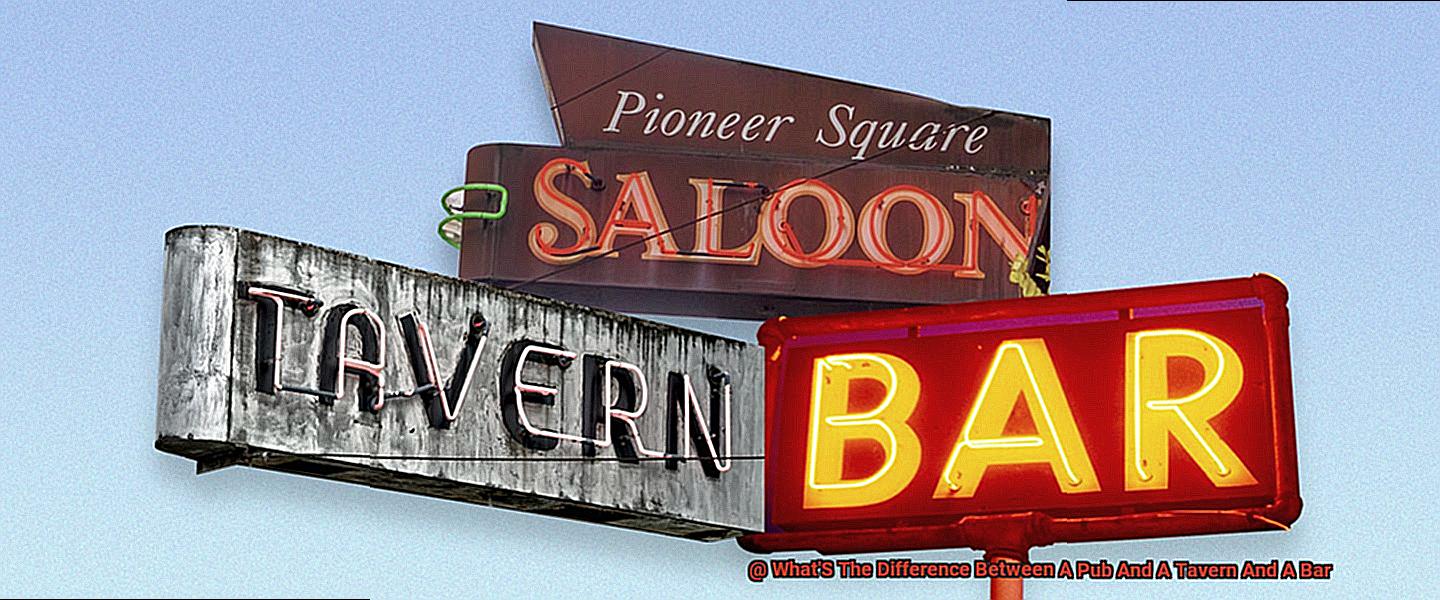
When it comes to unwinding and sipping on your favorite drink, choosing between a pub, tavern, or bar can be quite the conundrum. These places may seem similar at first glance, but they each possess their own distinctive vibes and experiences. So, let’s unravel the secrets behind these social hotspots and discover what sets them apart.
Join us as we embark on a journey through time to explore the origins of pubs, taverns, and bars. We’ll delve into their individual atmospheres and uncover the services they offer. By the end of our adventure, you’ll have a newfound appreciation for these beloved gathering spots that captivate people all around the globe. So grab a seat, get comfortable, and let’s dive into the fascinating world of pubs, taverns, and bars.
What’s the difference between a pub and a tavern and a bar
Contents
- 1 What’s the difference between a pub and a tavern and a bar
- 2 The Origins of Pubs
- 3 The Characteristics of Pubs
- 4 The History of Taverns
- 4.1 Ancient Origins: The Birth of Taverns
- 4.2 Middle Ages: Evolution of Taverns
- 4.3 Colonial America: Gathering Places and Information Hubs
- 4.4 Revolutionary Role: Meeting Places for Revolutionaries
- 4.5 Post-Revolution Shift: Lodging and Decline
- 4.6 Modern Taverns: Cozy and Nostalgic
- 4.7 Distinctions: Pubs, Taverns, and Bars
- 5 The Atmosphere of Taverns
- 6 Bars: A Modern Take on Socializing
- 7 Varieties of Alcohol Offered in Bars
- 8 Cultural Context and Its Impact on Pubs, Taverns and Bars
- 9 Visiting Establishments for an Authentic Experience
- 10 Conclusion
When it comes to enjoying a drink with friends or meeting new people, there are various establishments to choose from. Pubs, taverns, and bars are common terms that often get used interchangeably. However, each of these establishments has its own distinct characteristics and origins. In this article, we will dive deep into the world of pubs, taverns, and bars to understand the subtle differences that set them apart.
Pub: The Heart of British Socializing
- Originated from “public house” in the United Kingdom
- Relaxed and informal atmosphere for socializing
- Wide selection of beers on tap
- Traditional British food often served
Tavern: A Glimpse into History
- Historical association with lodging and accommodation
- Resting place for travelers in medieval Europe
- Offerings include spirits, wines, and beers
- Menu featuring hearty meals
Bar: Where Urban Vibes Take Over
- Commonly found in urban areas
- Lively atmosphere, music, and dancing
- Wide selection of alcoholic beverages, including cocktails and shots
- Some bars feature live entertainment or themed nights
Cultural Context:
- The term “pub” is used more broadly in the United States to describe any establishment serving alcohol.
- The lines between pubs, taverns, and bars can sometimes blur depending on specific offerings and ambiance.
The Origins of Pubs
In ancient Rome, tabernae were bustling establishments where people could gather to socialize, eat, and drink. These early taverns laid the foundation for the modern-day pub culture we know and love.
Medieval Europe: Alehouses and Taverns
As medieval Europe blossomed, pubs emerged as popular gathering places for locals. Known as alehouses or taverns, they provided a space for travelers, merchants, and villagers to come together.
Pubs as Social Hubs in Medieval Society
During medieval times, pubs and taverns played an integral role in society. They served as meeting places for socializing, conducting business, and even holding court hearings. Imagine sipping your ale while discussing politics or witnessing a lively debate.
The Industrial Revolution and Urban Pubs

The Industrial Revolution in the 18th and 19th centuries brought significant changes to pubs. With urbanization on the rise, pubs catered to the working class by offering affordable drinks and a sense of community.
Victorian Era: Pubs at the Heart of Community Life
Pubs truly came into their own during the Victorian era. They became iconic landmarks in neighborhoods, providing spaces for socializing, entertainment, and political discussions. Cheers to the pub’s enduring role in community life.
Bars: From Speakeasies to Modern-Day Hotspots
In contrast to pubs and taverns, bars have a more recent history. The Prohibition era in the United States gave birth to speakeasies – secret bars that operated covertly. After Prohibition, bars thrived and spread worldwide, focusing on cocktails and mixed drinks.
Distinctions and Blurred Lines
Today, the distinctions between pubs, taverns, and bars have become blurred. While they may be used interchangeably, each still carries its unique ambiance, offerings, and cultural associations. Pubs offer a cozy atmosphere, while bars are more energetic, and taverns evoke a sense of nostalgia.
The Characteristics of Pubs
Step into a pub, and you’ll immediately feel the vibrant energy and conviviality that permeates the air. Pubs, those quintessentially British establishments, have a unique atmosphere that sets them apart from other drinking establishments. In this blog post, we delve into the various characteristics that define pubs and make them beloved gathering places for locals and tourists alike.
Atmosphere:
Pubs epitomize a relaxed and informal ambiance, providing a welcoming space for people to unwind and socialize. With their cozy interiors, dim lighting, wooden furnishings, and sometimes crackling fireplaces, pubs exude warmth and charm. This inviting atmosphere fosters a sense of community, where patrons can strike up conversations with strangers or catch up with old friends.
Beverage Selection:
A hallmark of any pub is its extensive range of libations. Pubs offer an array of alcoholic and non-alcoholic beverages to cater to diverse tastes. From traditional ales and lagers to craft beers and ciders, there’s something to please every palate. Additionally, pubs often showcase local brews, allowing patrons to experience the flavors of the region.

Gastronomic Delights:
Beyond the drinks, pubs are renowned for their delectable pub grub. Indulge in classic British fare like fish and chips, bangers and mash, or shepherd’s pie. These hearty dishes perfectly complement a pint and add to the overall pub experience. However, modern pubs also embrace culinary innovation by incorporating international flavors or offering vegetarian and vegan options.
Interior Design:

The interior design of pubs is an art form in itself. From charmingly weathered walls adorned with vintage memorabilia to cozy nooks and crannies that invite relaxation, every detail contributes to the overall ambiance. Pubs expertly blend tradition with contemporary touches, creating a space that feels both timeless and modern.
Entertainment Options:
To keep the energy alive, many pubs offer live music or entertainment on certain nights. From acoustic performances to lively bands, these events infuse an extra dose of excitement into the pub atmosphere. Additionally, pubs may host trivia nights, karaoke sessions, or even comedy shows, ensuring there’s never a dull moment.
Customer Service:
The friendly and welcoming staff at pubs play a crucial role in enhancing the overall experience. With their attentive service and expert knowledge of beverages, they create an environment where patrons feel valued and comfortable. Whether you’re a regular or a first-time visitor, expect exceptional customer service that adds a personal touch to your pub adventure.
The History of Taverns
From ancient Rome to modern-day America, taverns have played a significant role in shaping social and cultural traditions. Let’s take a journey through time and explore the fascinating history of taverns.
Ancient Origins: The Birth of Taverns
- Originating in Europe, taverns can trace their roots back to ancient times.
- The word “tavern” comes from the Latin word “taberna,” meaning shop or shed.
- In ancient Rome, tabernae were small shops where people could buy food and drinks.
Middle Ages: Evolution of Taverns
- During the Middle Ages, taverns evolved into establishments that primarily served alcoholic beverages.
- Located near roads and marketplaces, taverns were convenient gathering places for travelers and traders.
- They also became important venues for social and political gatherings, as well as entertainment like music and storytelling.
Regulated Tavern Culture: England in the 14th Century
- In the 14th century, taverns in England became regulated by the government.
- Operating a tavern required licenses and adherence to strict laws and regulations.
Colonial America: Gathering Places and Information Hubs
- Taverns in colonial America were much like their European counterparts, serving as social hubs for locals and travelers.
- They also functioned as centers of communication, where news from other colonies or Europe would be shared and discussed.
Revolutionary Role: Meeting Places for Revolutionaries
- During the American Revolution, taverns gained even greater significance.
- They became meeting places for revolutionaries to exchange ideas and make plans.
Post-Revolution Shift: Lodging and Decline
- After the American Revolution, taverns began offering lodging for travelers.
- However, with the rise of saloons and bars in the 19th century, taverns started to decline in popularity.
Modern Taverns: Cozy and Nostalgic
- Today, taverns still exist but are often seen as quaint and historic establishments.
- They are known for their cozy atmosphere, hearty food, and selection of beer.
Distinctions: Pubs, Taverns, and Bars
- The distinction between a pub, tavern, and bar can vary based on region and cultural context.
- Generally, pubs focus on beer and socializing, while taverns may offer food and lodging in addition to drinks.
- Bars tend to be more modern establishments primarily serving alcoholic beverages.

The Atmosphere of Taverns
Step into a tavern, and you’ll be transported to a bygone era, where the air is thick with stories and the clinking of glasses mingles with hearty laughter. Taverns, historically known as gathering places for travelers and locals alike, have always been cherished for their warm and welcoming atmosphere.
Cozy Charm and Rustic Ambiance
Taverns exude a cozy charm that instantly puts you at ease. As you enter, you’ll be greeted by the sight of wooden furniture, softly lit by flickering candles or gas lamps. The crackling fireplace adds a comforting warmth, inviting you to relax and unwind. The decor reflects a traditional or historical theme, adorned with vintage artwork and antique items that tell tales of days gone by.
Lively Conversations and Entertainment
Taverns are vibrant hubs of social activity. Patrons can be found engaged in lively conversations, sharing stories of their travels or discussing local news. To add to the convivial atmosphere, taverns often offer entertainment options such as live music or games like darts or billiards. These activities foster a sense of camaraderie among patrons, creating an environment where friendships are forged.
Knowledgeable and Friendly Staff
The staff in taverns play a vital role in cultivating the welcoming environment. They are known for their friendly demeanor and attentive service, ensuring that customers feel right at home. Moreover, they often possess a wealth of knowledge about the history of the establishment or the local area. Don’t hesitate to strike up a conversation with them and uncover hidden gems about your surroundings.
Hearty Fare and Refreshing Libations
When it comes to food and drink offerings, taverns excel at providing satisfying fare that warms both body and soul. Their menus feature classic pub dishes like juicy burgers, hearty sandwiches, steaming soups, and comforting stews. As for libations, taverns pride themselves on their extensive selection of beers on tap. From local craft brews to popular national brands, there’s something to tantalize every taste bud. For those who prefer alternatives, taverns often offer a selection of wines, spirits, and specialty cocktails.
A Lively Energy
While taverns are synonymous with relaxation, they can also be vibrant and energetic during peak hours or on weekends. As crowds of locals and visitors gather, the tavern comes alive with an infectious energy. This lively atmosphere adds to the overall experience and creates lasting memories.
In conclusion, taverns are more than just places to eat and drink—they are sanctuaries that offer a respite from the outside world. With their cozy charm, historical ambiance, and sense of community, taverns continue to be cherished gathering places where stories are shared, friendships are formed, and memories are made.
Bars: A Modern Take on Socializing
In this section, let’s take a closer look at the modern take on socializing at bars and compare it to pubs and taverns. As an expert in this field, I have firsthand knowledge and experiences that will help provide insights into the differences between these places.

History and Evolution:
- Pubs: Pubs have a long history in British culture, originating in the Roman era. They were communal spaces where locals gathered to enjoy a pint of beer or ale. Pubs had a cozy and welcoming atmosphere, with wooden interiors, fireplaces, and a sense of community.
- Taverns: Taverns emerged in medieval Europe along trade routes, catering to travelers. They offered lodging, food, and drink and had larger spaces and more extensive menus compared to pubs.
- Bars: Bars have evolved over time to become more than just places to grab a drink. They are social hubs where people gather to relax, socialize, and connect with others. Bars are associated with urban areas and cater to a diverse range of customers.
Ambiance and Decor:
- Pubs: Pubs have a traditional and rustic feel, with cozy interiors, wooden furniture, and fireplaces.
- Taverns: Taverns also have a rustic ambiance but may have larger spaces and more commercialized settings.
- Bars: Bars embrace a more contemporary aesthetic, featuring sleek designs, modern furniture, ambient lighting, and sometimes live music or entertainment options.
Social Dynamics:
- Pubs: Pubs are known for their close-knit communities where locals gather to socialize.
- Taverns: Taverns catered to travelers but still provided opportunities for socializing among patrons.
- Bars: Bars attract a diverse crowd of tourists, young professionals, and college students. The atmosphere is livelier, with people mingling and engaging in conversations with both friends and strangers.
Technology Integration:
- Pubs: Pubs traditionally focused on face-to-face interaction without much reliance on technology.
- Taverns: Taverns also had limited technology integration, focusing more on providing basic amenities for travelers.
- Bars: Many bars now offer free Wi-Fi, charging stations for electronic devices, and interactive games or digital jukeboxes. This integration of technology enhances the overall social experience.
Varieties of Alcohol Offered in Bars
When it comes to the varieties of alcohol offered in bars, the options are vast and diverse. Whether you’re a beer lover, a wine connoisseur, or a cocktail enthusiast, there’s something for everyone. Let’s explore the different types of alcohol you can expect to find in bars.
Beer:
Bars typically have a wide selection of beers, ranging from popular domestic and international brands to local craft brews. You’ll find a variety of styles, including lagers, ales, stouts, IPAs, and more. Some bars even have rotating taps that feature seasonal or limited-edition beers, allowing patrons to try something new with each visit.
Wine:
For wine lovers, bars often offer an assortment of reds, whites, and rosés. You can expect to find familiar varietals like Cabernet Sauvignon, Chardonnay, Merlot, Pinot Noir, Sauvignon Blanc, and more. Bars may also have a selection of sparkling wines and champagne for those special occasions or celebratory moments.
Spirits:
When it comes to spirits, bars have an extensive range of options. Whiskey enthusiasts can choose from bourbon, scotch, rye, and more. Vodka lovers can explore flavored or infused varieties that add a unique twist to classic cocktails. Rum lovers can indulge in light or dark rum, perfect for sipping or mixing into tropical concoctions. Tequila aficionados can choose between silver or reposado tequila for their margaritas or shots. Gin drinkers can enjoy both classic London dry gin or experiment with botanical gins that offer a range of flavors.
Cocktails:
One of the highlights of any bar experience is the opportunity to enjoy expertly crafted cocktails. Bars often have skilled mixologists who create custom drinks tailored to individual preferences. From classic cocktails like the Old Fashioned and Martini to more adventurous creations, bars are known for their unique and creative libations. Many bars also have signature cocktails that become crowd favorites and leave a lasting impression.
It’s important to remember that the varieties of alcohol offered can vary between different bars. Some bars may specialize in craft beer and have an extensive selection of unique brews, while others may focus on curated wine lists or specialize in specific spirits. Additionally, individual establishments may have their own take on classic cocktails or feature specialty drinks that reflect the local culture or regional flavors.
Cultural Context and Its Impact on Pubs, Taverns and Bars
Pubs, taverns, and bars are not just places to grab a drink; they are cultural institutions that reflect the unique social, historical, and economic factors of their respective regions. Understanding the impact of cultural context on these establishments is crucial to appreciating their atmosphere, offerings, and regulations. In this blog post, we will explore how cultural context shapes the experience of pubs, taverns, and bars around the world.
Pubs: A Cozy Haven for Socializing
In countries like Ireland and England, pubs hold a special place in the hearts of locals. They are more than just drinking establishments; they are community hubs where people come together to unwind and connect. Pubs in these regions often feature:
- Warm and welcoming atmospheres with wooden interiors
- Traditional music playing in the background
- Local memorabilia on display
Taverns: Nostalgia and American Hospitality
Taverns have a rich history in American culture. Originating during the colonial era, they served as meeting places for travelers and locals alike. Today, taverns evoke a sense of nostalgia for a bygone era and can be found in historic areas or tourist destinations. Some key features of taverns include:
- Rustic charm with historic architecture
- Traditional American fare like burgers and fried chicken
- An emphasis on hospitality and friendly service
Bars: Urban Nightlife and Contemporary Vibes
Bars cater to a more contemporary crowd, often associated with urban nightlife and younger demographics. They offer a diverse range of alcoholic beverages and focus on creating an engaging experience through live music, DJs, or themed nights. Key features of bars include:
- Varied ambiance, from casual and laid-back to trendy and upscale
- Extensive drink menus with craft beers, cocktails, and global influences
- A vibrant and energetic atmosphere that attracts a hip and diverse crowd
Drinks and Food Offerings: Reflecting Cultural Tastes
Cultural context influences the types of drinks and food served in pubs, taverns, and bars. For example:
- Traditional Irish pubs prioritize serving Irish beers like Guinness or Smithwick’s
- Contemporary bars in cosmopolitan cities offer craft beers, cocktails, and fusion cuisine reflecting global influences
Regulations: Shaping the Nightlife Experience
Cultural norms and regulations regarding alcohol consumption also impact the atmosphere of these establishments. Factors to consider include:
- Operating hours: Some countries have strict regulations on the hours during which pubs, taverns, and bars can operate.
- Age restrictions: Different regions have varying laws regarding the legal drinking age, which affects the clientele and overall atmosphere.
- Alcohol availability: Some countries may have restrictions on the types or strength of alcoholic beverages that can be served.
Visiting Establishments for an Authentic Experience
Today, we’re diving into the topic of seeking out local establishments for an authentic cultural experience. Now, I have to say, I’m no stranger to this concept. In my years of globetrotting, I’ve come to realize that there’s no better way to truly immerse yourself in a new place than by stepping into the local pubs, taverns, and bars.
Now, you might be wondering why these places are so special. Well, let me tell you – these spots are like windows into the soul of a community. When you walk into a pub, for example, you’re instantly enveloped in a cozy atmosphere that’s steeped in tradition. The wooden interiors, dim lighting, and that unmistakable smell of good ol’ beer – it’s like stepping back in time. And let’s not forget the lively conversations and laughter that fill the air. It’s a true community space where locals gather to unwind, catch up with friends, and even engage in some spirited debates.
Taverns, on the other hand, offer a slightly different experience. These rustic-chic establishments are all about casual dining and serving up delicious dishes alongside your favorite drink. Picture exposed brick walls, warm wooden furniture, and a menu that tantalizes your taste buds. Taverns have a knack for blending history with modernity, creating an ambiance that feels both familiar and exciting.
And then we have bars – the epitome of cosmopolitan coolness. These sleek and contemporary establishments cater to a more modern crowd. The atmosphere is electric, with trendy decor, upbeat music, and an extensive selection of drinks – from craft cocktails to top-shelf spirits. Bars are where you go when you want to let loose, dance the night away, and make memories that will last a lifetime.
But what makes these places truly authentic? Well, it’s the fact that they are frequented by locals. When you step foot into a pub, tavern, or bar, you’re not just a tourist passing through. You become part of the fabric of the community, even if it’s just for a night. You get to interact with locals, hear their stories, and maybe even make some lifelong friends.
Now, I should mention that not all pubs, taverns, and bars are created equal. Each has its own unique vibe and offerings. That’s why it’s important to do your research and seek out the ones that truly embody the local culture. Ask the locals for recommendations, check out online reviews, and don’t be afraid to venture off the beaten path. Trust me, the extra effort is totally worth it.
Conclusion
In conclusion, while the terms pub, tavern, and bar are often used interchangeably, there are subtle differences that set them apart.
A pub is a cozy establishment with a focus on serving alcoholic beverages and providing a social gathering space for locals. It exudes a warm and welcoming atmosphere, often adorned with traditional decor and offering hearty food options.
On the other hand, a tavern tends to have a more historical connotation, evoking images of old-world charm and rustic interiors. It typically offers lodging accommodations along with food and drink services.
It can range from casual sports bars to upscale cocktail lounges, catering to diverse clientele and offering an extensive selection of drinks.


